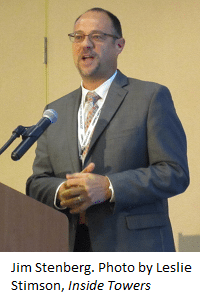 Stocks
in cell-tower companies — which have been in a general decline on the
prospect of dealing with one less major wireless-carrier customer — are
rising while the carriers involved took a significant drop. Percentage
of growth for the day (10/30) shown below:
Stocks
in cell-tower companies — which have been in a general decline on the
prospect of dealing with one less major wireless-carrier customer — are
rising while the carriers involved took a significant drop. Percentage
of growth for the day (10/30) shown below:- American Tower (NYSE:AMT) is up 2.8%;
- SBA Communications (NASDAQ:SBAC) up 2.4%;
- Crown Castle (NYSE:CCI) up 2.8%.
- T-Mobile (TMUS) down 5.3%
- Sprint (S) down 9.3%
SoftBank Group Corp., will reportedly call off negotiations to merge its subsidiary, Sprint Corp., with T-Mobile U.S., according to Nikkei Asian Review, a Japanese financial news agency. It said that SoftBank may approach T-Mobile’s parent company, Deutsche Telekom as early as tomorrow, to end the deal.
Inside Towers reported on October 13, that the merger was unlikely, citing a Reuters article that said the Department of Justice would “likely recommend putting a stop to any further plans” due to anti-trust regulations blocking its path. Continue Reading

 New
FCC Commissioner Brendan Carr is leading the agency’s efforts to
streamline wireless infrastructure deployment. In his first speech as a
Commissioner, Carr told attendees of the
New
FCC Commissioner Brendan Carr is leading the agency’s efforts to
streamline wireless infrastructure deployment. In his first speech as a
Commissioner, Carr told attendees of the





 There’s
a lot of interest from citizens, states, counties and the federal
government to bring broadband to rural America. The biggest issue is:
“How do you make it feasible?” broadband public safety advocate
There’s
a lot of interest from citizens, states, counties and the federal
government to bring broadband to rural America. The biggest issue is:
“How do you make it feasible?” broadband public safety advocate In
order to jumpstart the communications restoration in Puerto Rico and
the U.S. Virgin Islands, FCC Chairman Ajit Pai proposed allowing
carriers to use their Universal Service Fund allocations. Pai circulated
a proposal among his colleagues for a vote; if passed, the order would
quickly make available up to $96.9 million to repair wireline and
wireless communications in the hurricane-ravaged islands.
In
order to jumpstart the communications restoration in Puerto Rico and
the U.S. Virgin Islands, FCC Chairman Ajit Pai proposed allowing
carriers to use their Universal Service Fund allocations. Pai circulated
a proposal among his colleagues for a vote; if passed, the order would
quickly make available up to $96.9 million to repair wireline and
wireless communications in the hurricane-ravaged islands. “Of
the sites we’ve been able to gain access to and inspect, it appears
that the structural integrity of our towers has held,” Matt Peterson,
Vice President, Communications, American Tower told
“Of
the sites we’ve been able to gain access to and inspect, it appears
that the structural integrity of our towers has held,” Matt Peterson,
Vice President, Communications, American Tower told